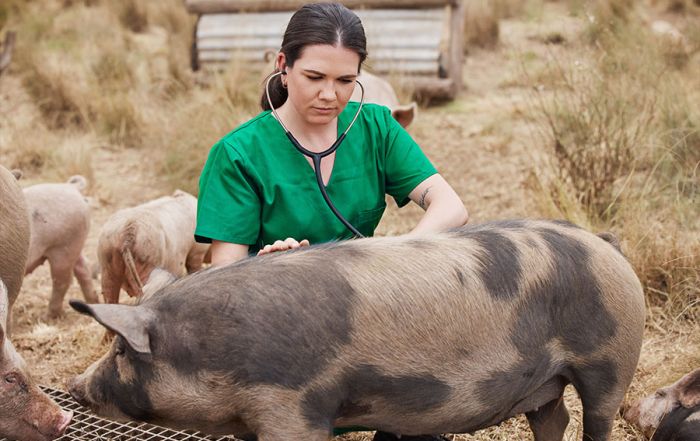Encouraging Behavior Change among Foodservice Employees
A few months ago, we published a blog about the human factor and food safety. Within that blog, we discussed a bit about behavior change, including the subjective norm. You might recall the subjective norm refers to the culture that either supports food safety, or not.
In training employees and managers about food safety, besides the subjective norm, we need to talk about the attitudes and barriers to food safety implementation. In academe, we always like to think of things in silos, that they are not dependent upon one another, but in the real-world, we know this is simply not the case. For example, if you have a positive food safety culture, positive attitudes and removing barriers to positive food safety behaviors would logically follow. Absent of either one of those, a positive food safety culture is not likely to exist.
What is each member of your team’s true attitude about food safety? You know…the attitude they have when your ears are not listening, or you are not in the kitchen. Part of starting to change attitudes is the employee (or manager) having a solid understanding of the rationale behind our practices. For example, a few years ago we were working with a large school system and helping them to improve their foods safety program. One of the things a colleague and I observed while doing on-site inspections was the employees were nice enough to have filled out the cooler temperature log for us. But, not just for that hour, for the entire week, yet it was only 7:45 on a Tuesday morning. Those employees were either clairvoyant or they were dry logging, and certainly the former couldn’t be true. The truth is that those employees understood what they were asked to do, but really didn’t comprehend WHY they were doing it. Thinking about it, if you had never worked in a commercial kitchen before, when was the last time you recorded a refrigerator temperature at home? Taking it one step further, when was the last time you made someone ill because you didn’t have proper refrigerator temperatures at home? It is easy to surmise that the employees who did this are lazy and simply did not want to do it, but we generally find that there is more to the story than this and simply taking the time to help them realize why we do these tasks helps them connect the dots to improve their behavior.
What is each member of your team’s true attitude about food safety? You know…the attitude they have when your ears are not listening, or you are not in the kitchen.
Removing barriers is also important. It is important to note these can be actual barriers or perceived barriers. I once had an employee who told me it took too long to wash his hands. Thus, he could not do it, because we (referring to the managers) were so focused on ticket times and getting food out to the guests, he simply didn’t have time to wash he hands that much. There were at least two wrong things with that statement. First, it really doesn’t take too long to wash your hands. In reality, you can wash your hands 12 times in four minutes (we even made a poster in a previous study to explore the impacts it would have on behavior). The second was that we were conveying the wrong message to our employees (but that will be the focus of another blog). In this case, it was a perceived barrier that was stopping him from washing his hands. An actual barrier we once observed while doing on-site observations at a restaurant was the lack of thermometers. When we asked the manager about the notable absence of any thermometers in the kitchen, he exclaimed he was not going to buy any more this quarter, because the employees were stealing them. While we could discuss what was really happening with the thermometers (and I doubt the employees were stealing these highly coveted bimetallic stemmed thermometers), regardless of what was happening with them, we need to have them available for our employees if we ever want them to take a temperature.
Although my life as a researcher and teacher at a university looks much different than it did a few years ago when I was in the foodservice industry, I do still appreciate and understand the challenges that come with running a foodservice operation. As an operator, you have many different irons in the fire, but thinking about modifying and changing employee behavior can have positive results throughout the organization, not just in the realm of food safety.
There are many aspects to anyone’s actual behavior. Taking the time to think through why an employee might do what they do can be key to changing their behavior for the positive – whether it be food safety related or not. As we have noted before, every operation has a food safety culture, we are hoping yours is a positive one. And if your culture is not quite there yet, perhaps exploring ways to encourage behavior change among your employees may be on the menu for the new year.
We hope you were able to join us on November 17th for our last SafeBites webinar of 2021, entitled, “Practicing Good Agriculture: A Primer for Foodservice Operations”. We will be announcing dates for the 2022 Safebites Webinar Series in the next month or so. If you have topics, you’d enjoy learning more about, please reach out and let me know. Risk Nothing.
The Antibiotic Debate in Our Food Chain
The discovery of antibiotics in medical science is regarded as one of the most important medical [...]
Exposing the Risks of Raw Milk
When I began my career in the food safety area several years ago, I never dreamed [...]
Navigating the Latest Listeria Outbreak
I am starting to feel like a member of the Bad News Bears, the guy that [...]
Enhancing Safety and Adding Flavor: The Role of Additives in your Food Supply
Last week, I ran across a post on Facebook from a childhood friend denouncing additives in [...]









